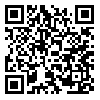Wed, Dec 17, 2025
Volume 15, Issue 2 (Spring 2025)
PTJ 2025, 15(2): 151-164 |
Back to browse issues page
Download citation:
BibTeX | RIS | EndNote | Medlars | ProCite | Reference Manager | RefWorks
Send citation to:



BibTeX | RIS | EndNote | Medlars | ProCite | Reference Manager | RefWorks
Send citation to:
Ebrahimi A, Jafarpishe A S, Vahedi M, Izadi Laybidi M, Mohammadi S. Comparison of the Effectiveness of Gamification, Tracking Patterns, and Visual Gauges in Improving Hand Motor Performance Through Biofeedback. PTJ 2025; 15 (2) :151-164
URL: http://ptj.uswr.ac.ir/article-1-662-en.html
URL: http://ptj.uswr.ac.ir/article-1-662-en.html
Ayda Ebrahimi1 

 , Amir Salar Jafarpishe *2
, Amir Salar Jafarpishe *2 

 , Mohsen Vahedi3
, Mohsen Vahedi3 

 , Marzieh Izadi Laybidi4
, Marzieh Izadi Laybidi4 

 , Somayeh Mohammadi5
, Somayeh Mohammadi5 




 , Amir Salar Jafarpishe *2
, Amir Salar Jafarpishe *2 

 , Mohsen Vahedi3
, Mohsen Vahedi3 

 , Marzieh Izadi Laybidi4
, Marzieh Izadi Laybidi4 

 , Somayeh Mohammadi5
, Somayeh Mohammadi5 


1- Department of Ergonomics, Faculty of Rehabilitation, University of Social Welfare and Rehabilitation Sciences, Tehran, Iran.
2- Department of Ergonomics, Faculty of Rehabilitation, University of Social Welfare and Rehabilitation Sciences, Tehran, Iran. & Neuromusculoskeletal Rehabilitation Research Center, University of Social Welfare and Rehabilitation Sciences, Tehran, Iran.
3- Substance Abuse and Dependence Research Center, University of Social Welfare and Rehabilitation Sciences, Tehran, Iran. & Department of Biostatistics and Epidemiology, Faculty of Social Health, University of Social Welfare and Rehabilitation Sciences, Tehran, Iran.
4- Department of Ergonomics, School of Public Health, Iran University of Medical Sciences, Tehran, Iran.
5- Department of Physiotherapy, Faculty of Rehabilitation, University of Social Welfare and Rehabilitation Sciences, Tehran, Iran.
2- Department of Ergonomics, Faculty of Rehabilitation, University of Social Welfare and Rehabilitation Sciences, Tehran, Iran. & Neuromusculoskeletal Rehabilitation Research Center, University of Social Welfare and Rehabilitation Sciences, Tehran, Iran.
3- Substance Abuse and Dependence Research Center, University of Social Welfare and Rehabilitation Sciences, Tehran, Iran. & Department of Biostatistics and Epidemiology, Faculty of Social Health, University of Social Welfare and Rehabilitation Sciences, Tehran, Iran.
4- Department of Ergonomics, School of Public Health, Iran University of Medical Sciences, Tehran, Iran.
5- Department of Physiotherapy, Faculty of Rehabilitation, University of Social Welfare and Rehabilitation Sciences, Tehran, Iran.
Abstract: (2306 Views)
Purpose: The scientific methods for evaluating muscle activity involve the use of various techniques. Biofeedback, which consists of equipment providing individuals with real-time feedback regarding their physiological responses, is crucial in enhancing neuromuscular function. Despite its potential, the effectiveness of biofeedback interventions on motor performance remains a topic of debate. This study aimed to investigate the effectiveness of different biofeedback interventions on motor performance improvement in hand. This study contributes to a more comprehensive understanding of the role of biofeedback in motor function improvement in hand.
Methods: A total of 60 individuals were randomly assigned to one of four groups: Aircraft, visual gauge, pattern-tracking, and a control group. Preintervention and postintervention assessments were performed to evaluate motor performance in hand. Statistical analysis was conducted using the paired t-test to compare the root mean square error between groups.
Results: The pattern-tracking group demonstrated significant motor performance improvement, with a statistically significant difference in root mean square error (P<0.001). This finding suggests that this specific biofeedback approach may effectively enhance motor performance in hand.
Conclusion: The study’s findings support the task-oriented approach, which emphasizes the importance of adaptability to environmental changes, and the part versus whole training theory, which argues that breaking down a motor task into smaller components improves performance. The results highlight the importance of similar practices to the final objective for motor function improvement in the hand area. The study’s findings have implications for developing effective biofeedback interventions for motor performance improvement in individuals with hand-related motor impairments. Furthermore, the conclusions can be applied to various populations, including athletes and individuals in different lines of work, who can benefit from improved motor performance in their hands.
Methods: A total of 60 individuals were randomly assigned to one of four groups: Aircraft, visual gauge, pattern-tracking, and a control group. Preintervention and postintervention assessments were performed to evaluate motor performance in hand. Statistical analysis was conducted using the paired t-test to compare the root mean square error between groups.
Results: The pattern-tracking group demonstrated significant motor performance improvement, with a statistically significant difference in root mean square error (P<0.001). This finding suggests that this specific biofeedback approach may effectively enhance motor performance in hand.
Conclusion: The study’s findings support the task-oriented approach, which emphasizes the importance of adaptability to environmental changes, and the part versus whole training theory, which argues that breaking down a motor task into smaller components improves performance. The results highlight the importance of similar practices to the final objective for motor function improvement in the hand area. The study’s findings have implications for developing effective biofeedback interventions for motor performance improvement in individuals with hand-related motor impairments. Furthermore, the conclusions can be applied to various populations, including athletes and individuals in different lines of work, who can benefit from improved motor performance in their hands.
Type of Study: Research |
Subject:
General
Received: 2024/07/23 | Accepted: 2024/10/23 | Published: 2025/04/1
Received: 2024/07/23 | Accepted: 2024/10/23 | Published: 2025/04/1
Send email to the article author
| Rights and permissions | |
 |
This work is licensed under a Creative Commons Attribution-NonCommercial 4.0 International License. |



